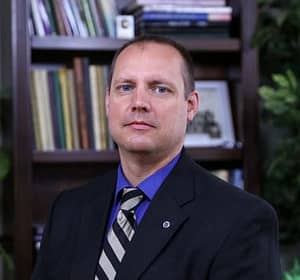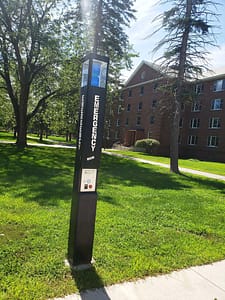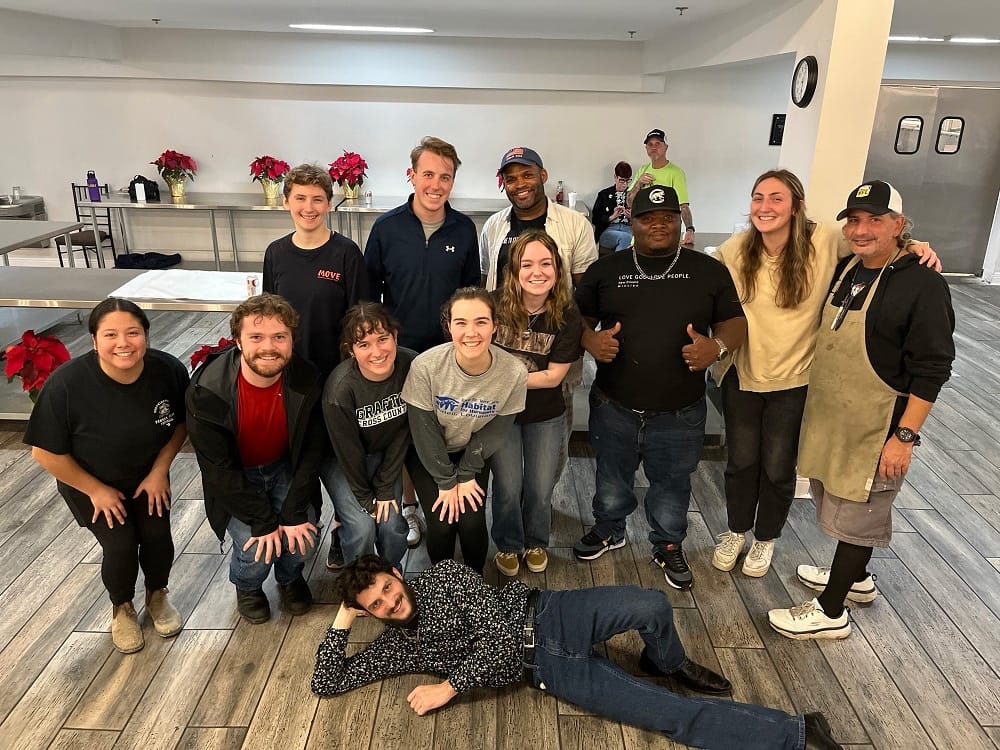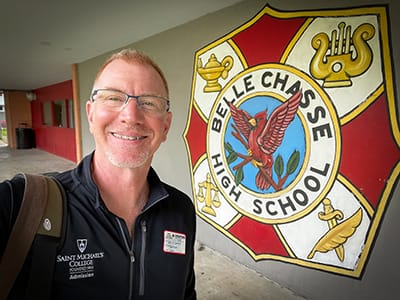Superior safety app allows slow phase-out of ‘blue lights’
Popular 'LiveSafe' widely used by students since 2014, but much of obsolete old system will remain functional
As at an increasing number of other colleges nationwide, the success and popularity of an “app” for smartphones to keep students connected with campus Public Safety will allow Saint Michael’s College to gradually phase out an obsolete “blue light” campus system that was installed in the early 1990s – a system which, according to the College’s Public Safety Director Doug Babcock, no student has actually used in an emergency situation for many years.

Doug Babcock
For six years St. Mike’s students have had access to an app called LiveSafe. This app allows students to check-in with public safety if they’re walking alone at night or in other situations when they’re feeling unsafe. Students can also send out an emergency alert that lets security officers know they’re in trouble, and gives students the ability to send pictures or video clips through the app, anonymously if they chose.
Since LiveSafe was first brought online in the spring of 2014, Public Safety has received over 3,700 tips and more than 150 emergency calls. “We have also logged almost 300 SafeWalks, a feature that allows a student to use the GPS on their phone to have someone, either a friend, family member or Public Safety, follow them as they walk or travel,” said Babcock. “Many students download the app in their first year and since 2014 over 4,000 users have registered with the College.”
Babcock said the old blue-light system of poles around campus with buttons and speakers that anyone in an emergency could push and talk to Public Safety directly had the distinct relative limitation that “you have to stand by the phone to report the issues and if, for example, you felt you were being followed, you couldn’t touch the button and then wait there to talk to us.” The only instances of the buttons even being pushed on recent record are a student needing a ride in 2016, and a few repeat prank button-pushes by non-student passers-by.
He said that a recently-begun incremental phase-out and removal of the blue-light system by contractors who might be visible to those arriving back on campus soon simply involves taking out the oldest units as they fail rather than replacing them. Therefore, many newer blue-light stations that can be seen on poles around campus to reach public safety or dedicated phones in residence halls still remain operative and likely will work well into the future.

One of the blue-light- system poles installed around campus for communicating with Public Safety in emergencies.
“We still test them every year so and if they are up and functioning and doing well, they are going to stay until they don’t function,” said Babcock, further explaining that seven failed older units will be removed from various locations in the coming weeks — six on main campus and one on North Campus, followed by others if and when they might stop functioning.
“We want to have the word out ahead of time that we are relying more on the much greater safety communication system that we already have with the LiveSafe app,” he said of a decision on the matter that was collaborative among Public Safety, Student Life, Facilities and Information Technology. “We all have a hand in the system,” Babcock said.
The newest blue light poles were installed perhaps five years ago with the construction of newer residence halls and buildings, and so will likely remain in good working order for many years to come, but “everything prior to that is many years old, with some likely in the 20 year old range at least,” he said of the blue-light technology that “became very popular in the 90s.”
“Back in the day, even before the blue-light-systems, older folks will remember that every dorm room used to have a campus phone that the College provided, so every student had access to the switchboard,” he said. But, with the universal use of cellphones by students in recent years, dorm rooms no longer necessarily have landline phones — though some residence halls have dedicated phones connected to Public Safety still in some locations. “Any that are functioning we will leave in place,” he said.
Babcock noted that when Vermont Public Radio reported in February 2020 on Castleton University in Vermont introducing their similar public safety app, St. Mike’s was already leading the way ahead of the curve. Noted VPR reporter Amy Kolb Noyes in that piece, “Most of Vermont’s college campuses use the blue light system, but so far only Castleton and St. Michael’s College in Colchester have the added security of a public safety app. St. Mike’s students have access to an app called LiveSafe.”
In the words of Babcock, “Because of robustness of the LiveSafe app, we will be relying increasingly on a newer and more secure system of keeping students safe going forward.”





